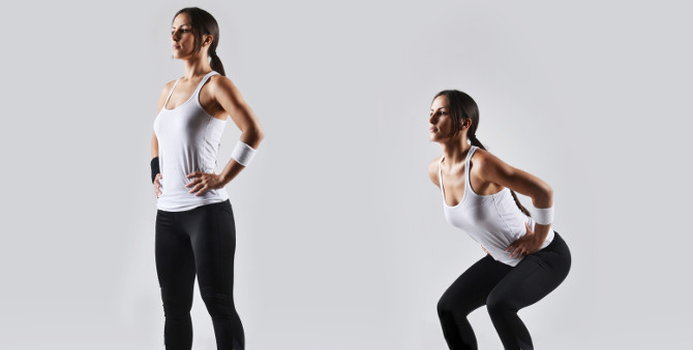Squat exercises primarily work the muscle groups found in the legs, plus build core strength and help increase back support. The traditional exercise has many variations that don't require the use of weights while providing excellent results.
Squat Exercises without Weights- With feet at least shoulder width apart, straighten both legs and the back in a locked position. Begin the traditional squat exercise by bending at the knees while maintain a straight and stable posture with the upper body. Make sure that the buttocks become at least parallel with both knees with each squat. Going past the parallel point will result in a deeper, more effective muscle strengthening exercise. The traditional squat targets the quadriceps and glutes, and strengthens the lower back and the core.
- Stand with feet together touching at the ankles. Place both arms directly outwards to form an upside-down L-shape with the body. Begin performing a normal squat in this fixed position. Although this exercise targets the same muscle groups as the traditional squat, the quadriceps become more isolated when pressing off of the floor, and balance improves.
- In a wide stance with toes pointed outward, perform traditional squats going beyond the parallel point. The hamstrings and glutes will become more isolated than in close or normal stances.
- With feet about shoulder width apart, perform traditional squats but jump on the way up, landing with feet in the same position. On the way up and through the jump, bring the knees to the chest as much as possible to maximize the landing impact.
- Place some sort of cushion, bench, chair or any stable and flat device that has the ability to act as a reference point on the floor directly behind the feet. Perform traditional squats but spring up as soon as the buttocks come in contact with the reference point device. These squats will help improve balance and the ability to break past the parallel point in other squat exercises.
- With one foot resting on a stable device, fully extend one leg to form an L shape. Perform multiple one-legged squats in order to isolate the muscles of each leg separately. This exercise helps those with injuries who must avoid the use of certain leg muscles or an entire leg altogether.
- Place the top of the foot on a stable device so that the leg fully extends, while facing the opposite direction of the resting device. Stride out with the leading leg to form a lunging position and perform a one legged squat. This squat exercise targets the quadriceps muscle group much more effectively than other compound leg squats.
Choose a leg workout routine that implements several squat exercises. Switching between the various exercises provides both compound and isolated muscle building and strength enhancing contractions for the leg muscles.
Prior to performing any sort of squat exercises with or without the addition of weights, slowly stretching the quadriceps, hamstrings and glutes will ensure less risk of injury and a better chance of successfully performing the proper techniques.



